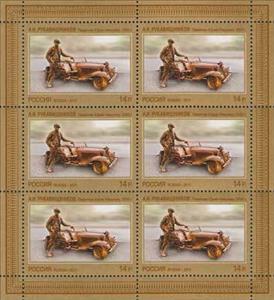Mini Sheet: Modern art Monument to Yury Nikulin (Russia 2011)
Modern art Monument to Yury Nikulin (Russia 2011)
12 September (Russia ) within release Art goes into circulation Mini Sheet Modern art Monument to Yury Nikulin face value 84 Russian ruble
| Mini Sheet Modern art Monument to Yury Nikulin in catalogues | |
|---|---|
| Michel: | Mi:RU 1747 Klb |
Mini Sheet is vertical format.
Also in the issue Art:
- Stamp - Modern art "Aidan" face value 14;
- Stamp - Modern art "Sea landscape" face value 14;
- Mini Sheet - Modern art "Sea landscape" face value 84;
- Stamp - Modern art "View of Borisoglebsky monastery" face value 14;
- Mini Sheet - Modern art "View of Borisoglebsky monastery" face value 84;
- Stamp - Modern art "Gymnasts of the USSR" face value 14;
- Mini Sheet - Modern art "Gymnasts of the USSR" face value 84;
- Stamp - Modern art Monument to Yury Nikulin face value 14;
- Mini Sheet - Modern art Monument to Yury Nikulin face value 84;
- Mini Sheet - Modern art "Aidan" face value 84;
- Stamp - Modern art "Village Akinshino" face value 14;
- Mini Sheet - Modern art "Village Akinshino" face value 84;
Mini Sheet Modern art Monument to Yury Nikulin it reflects the thematic directions:
Famous People refers to the fame and public attention accorded by the mass media to individuals or groups or, occasionally, animals, but is usually applied to the persons or groups of people (celebrity couples, families, etc.) themselves who receive such a status of fame and attention. Celebrity status is often associated with wealth (commonly referred to as fame and fortune), while fame often provides opportunities to make money.
A monument is a type of structure that was explicitly created to commemorate a person or event, or which has become relevant to a social group as a part of their remembrance of historic times or cultural heritage, due to its artistic, historical, political, technical or architectural importance. Examples of monuments include statues, (war) memorials, historical buildings, archaeological sites, and cultural assets. If there is a public interest in its preservation, a monument can for example be listed as a UNESCO World Heritage Site. The Palgrave Encyclopedia of Cultural Heritage and Conflict gives the next definition of monument:
An actor (or actress for females) is a person who portrays a character in a performance. The actor performs "in the flesh" in the traditional medium of the theatre, or in modern mediums such as film, radio, and television. The analogous Greek term is ὑποκριτής (hupokritḗs), literally "one who answers". The actor's interpretation of their role pertains to the role played, whether based on a real person or fictional character. Interpretation occurs even when the actor is "playing themselves", as in some forms of experimental performance art, or, more commonly; to act, is to create, a character in performance.
Art is a diverse range of human activities in creating visual, auditory or performing artifacts (artworks), expressing the author's imaginative or technical skill, intended to be appreciated for their beauty or emotional power. In their most general form these activities include the production of works of art, the criticism of art, the study of the history of art, and the aesthetic dissemination of art. The oldest documented forms of art are visual arts, which include creation of images or objects in fields including painting, sculpture, printmaking, photography, and other visual media. Architecture is often included as one of the visual arts; however, like the decorative arts, or advertising, it involves the creation of objects where the practical considerations of use are essential—in a way that they usually are not in a painting, for example. Music, theatre, film, dance, and other performing arts, as well as literature and other media such as interactive media, are included in a broader definition of art or the arts. Until the 17th century, art referred to any skill or mastery and was not differentiated from crafts or sciences. In modern usage after the 17th century, where aesthetic considerations are paramount, the fine arts are separated and distinguished from acquired skills in general, such as the decorative or applied arts.




